两类El Nio不同衰减型的演变特征及其与我国夏季降水的联系
2017-01-18陈圣劼何金海
陈圣劼,何金海
(1.江苏省气象台,江苏 南京 210008;2.南京信息工程大学 气象灾害教育部重点实验室,江苏 南京 210044)
陈圣劼1,何金海2*
(1.江苏省气象台,江苏 南京 210008;2.南京信息工程大学 气象灾害教育部重点实验室,江苏 南京 210044)
利用中国气象局743站日降水、NCEP-/NCAR大气环流、英国气象局Hadley中心全球月平均海表温度(SST)等资料,探讨了两类El Nio不同衰减型的演变特征及其对衰减阶段夏季(6-8月)我国降水异常分布的可能影响。根据海表温度异常(SSTA)沿赤道(5°S~5°N)的演变特征,EP-El Nio存在两种衰减型:自东向西(E-W)衰减(大于0.5℃的海温正距平首先在南美沿岸消失,并向西扩展)和自西向东(W—E)衰减(大于0.5℃的海温正距平首先在赤道中太平洋消失,并向东扩展);CP-El Nio存在3种衰减方式:对称(S)衰减(赤道中太平洋暖海温的发展和衰减关于某一峰值对称)、延迟(P)衰减(衰减阶段紧接着呈现EP-El Nio分布)、突然(A)衰减(衰减阶段紧接着发生EP-La Nia事件)。对于EP-El Nio,在华北、华南、长江和黄河(简称两河)之间及两河的上游地区,E-W与W-E衰减阶段夏季降水呈现完全相反的异常分布特征。E-W衰减阶段夏季两河之间及上游地区偏旱的可能性显著增大,华北地区降水异常偏多,长江以南略偏多;而W-E衰减阶段夏季,两河之间及上游地区降水偏多,降水异常大值中心主要位于沿江地区,华南大部和华北地区降水明显偏少。对于CP-El Nio的3种衰减方式:夏季降水异常大值带在S衰减方式下主要位于黄河和淮河之间;在P方式衰减时,出现在长江流域;而在A型衰减时,主要位于黄河下游地区。S和A衰减方式下,东北大部尤其东北北部降水偏少,而处于P衰减时,东北大部降水明显偏多;在西南地区,S衰减时夏季降水总体偏多,A衰减时情况相反;在西北北部地区,A衰减时偏旱,而S和P衰减时降水总体偏多。不同的衰减方式均对应不同的降水异常空间分布,区分衰减型使得两类El Nio次年我国夏季降水异常显著区的分布范围和信号强度均较未区分衰减型时有较好的改善,为我国汛期降水短期气候预测工作提供了重要依据。
两类El Nio;不同衰减型;演变特征;夏季降水
1 引言
2 资料和方法
所使用的主要数据集包括(1)NCEP/NCAR(National Center for Environmental Prediction/National Center for Atmospheric Research)大气环流再分析资料[22],水平分辨率为2.5°×2.5° ;(2)英国气象局Hadley中心全球月平均海表温度(SST)资料[23],空间分辨率为1°×1°;(3)日本气象厅JMA海洋各层温度资料(http://www.cgd.ucar.edu/cas/catalog/ocean/HistOcn_new.html),水平分辨率为1°×1°,海温垂向共分24层;(4)中国气象局743站日降水资料。分析时段均为1960年1月至2015年12月。夏季降水是指6、7、8月3个月降水累积。
3 两类El Nio不同衰减型的演变过程分析
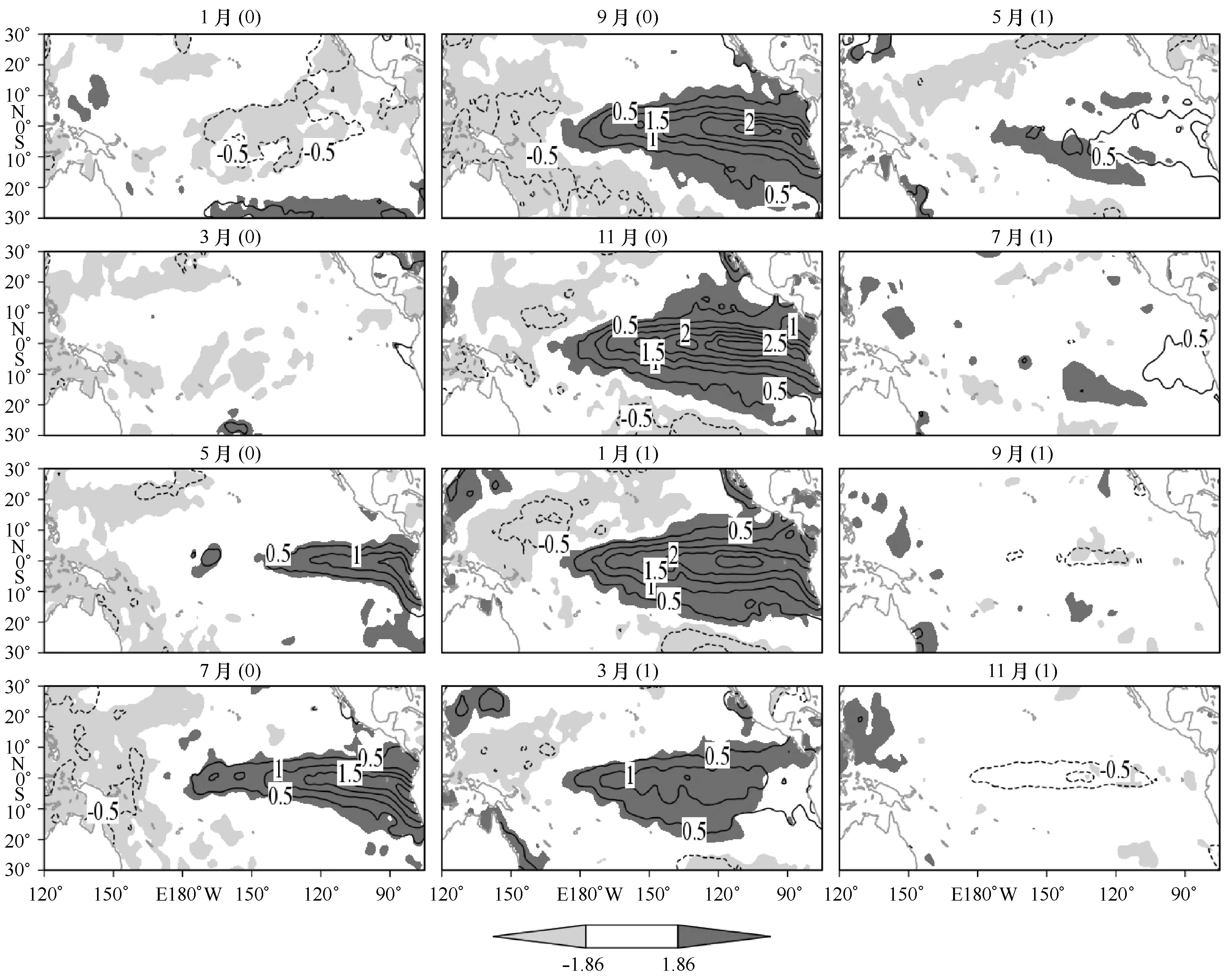
图1 5次EP-El Nio事件合成的SSTA随时间的演变Fig.1 Evolution of composite SSTA of five EP-El Nio events等值线间隔0.5℃,横坐标数字0表示当年,1表示次年,深(浅)色阴影表示正(负)异常通过信度0.10的显著性检验The interval of contour is 0.5℃,the number 0 (1) in the longitudinal coordinate indicates the current (next) year,deep/shadow shaded denote positive /negative anomalies exceeding the 0.10 significance level

图3 E-W衰减型(a)、W-E型(b)EP-El Nio事件沿赤道(5°S~5°N)次表层海温异常垂向分布随时间的演变Fig.3 Evolution of composite equatorial depth-longitude section of SSTA of EP-El Nio events decaying in E-W pattern (a) and W-E pattern (b) 0表示当年,1表示次年,等值线间隔为0.3℃(a)和0.5℃(b), 深(浅)色阴影区表示海温距平超过(低于)0.5℃(-0.5℃)The number 0 (1) indicates the current (next) year, the interval of contour is 0.3℃ in a and 0.5℃ in b, deep/ shadow shaded denote SSTA values exceeding /below 0.5/-0.5℃
由于E-W型和W-E型分别发生在20世纪80年代前后,可能对应ENSO循环演变结构的年代际变化。由于个例有限,这两种衰减方式的普适性还需进一步验证。

图4 9次CP-El Nio事件合成的SSTA随时间的演变Fig.4 Evolution of composite SSTA of nine CP-El Nio events 等值线间隔0.2℃,横坐标数字0表示当年,1表示次年,深(浅)色阴影表示正(负)异常通过信度0.10的显著性检验The interval of contour is 0.2℃,the number 0 (1) in the longitudinal coordinate indicates the current (next) year, deep/ shadow shaded denote positive /negative anomalies exceeding the 0.10 significance level
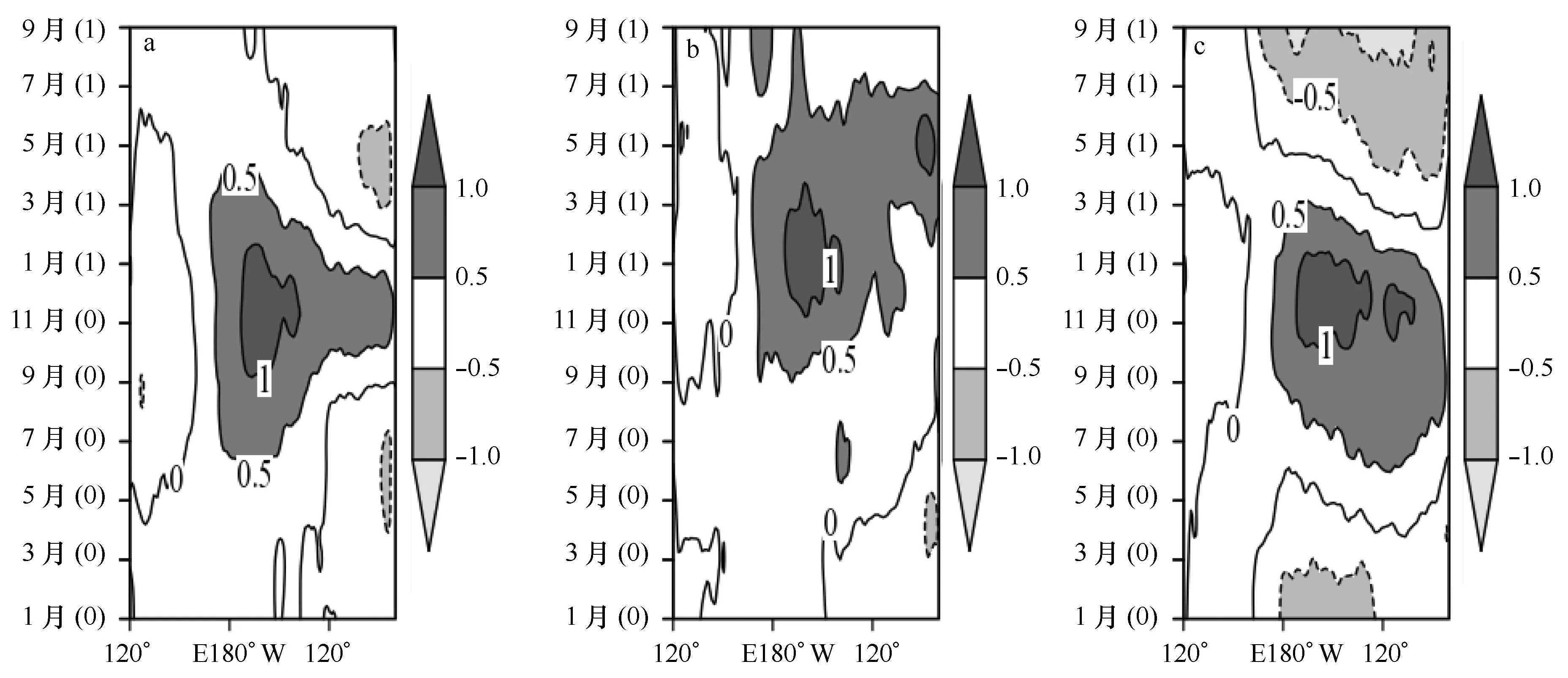
图5 CP-El Nio事件的3种衰减型沿赤道(5°S~5°N)SSTA随时间的演变,S型衰减(a)、P型(b)、A型衰减(c)Fig.5 Evolution of composite equatorial(5°S—5°N)SSTA of three types of CP-El Nio events, decaying in S type (a), decaying in P pattern (b), decaying in A pattern (c)纵坐标数字0表示当年,1表示次年,等值线间隔0.5℃, 深(浅)色阴影区表示海温距平超过(低于)0.5℃(-0.5℃)The number 0 (1) in the longitudinal coordinate indicates the current (next) year,the interval of contour is 0.5℃,deep/shadow shaded denote SSTA values exceeding /below 0.5/-0.5℃

图6
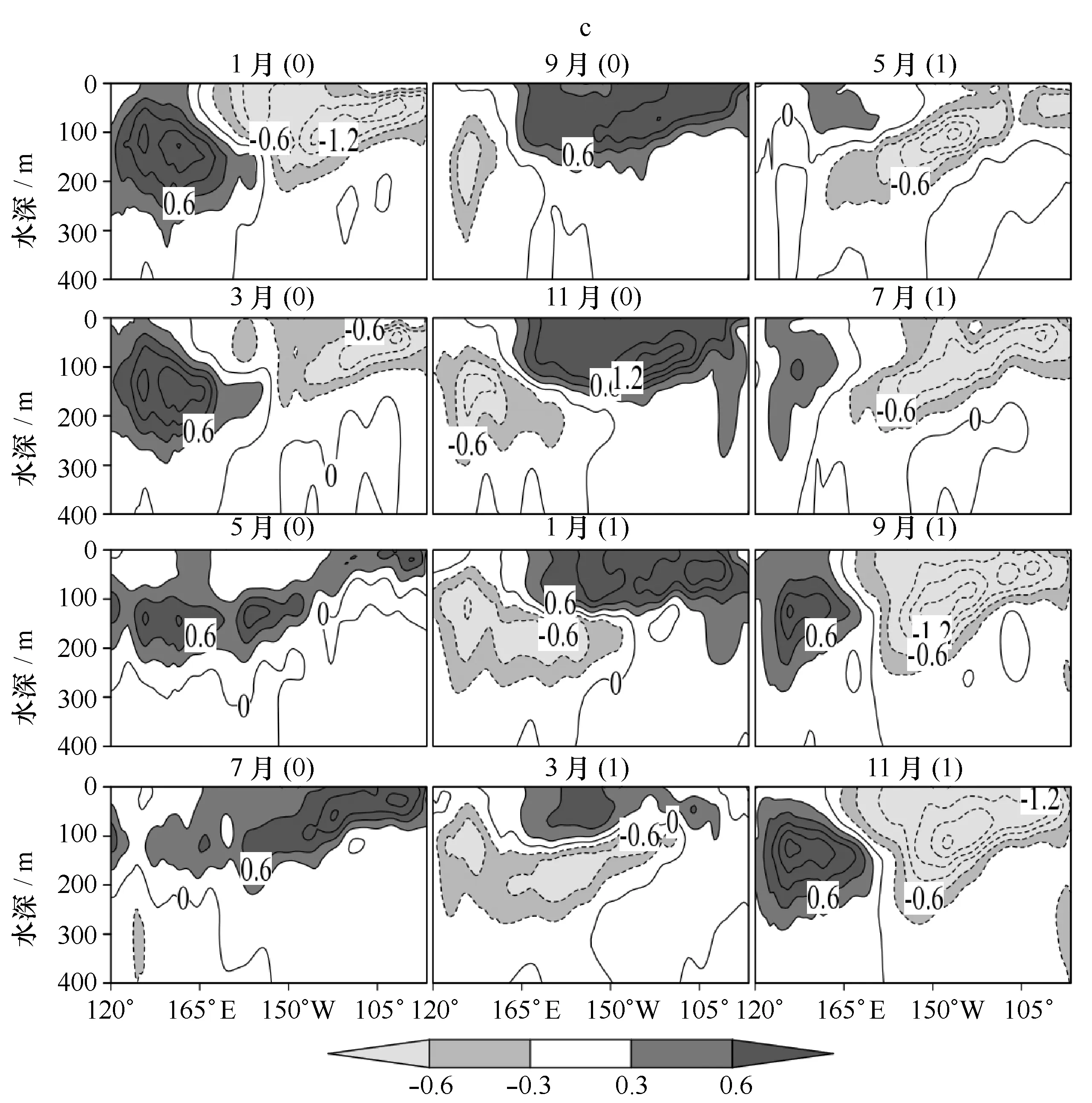
图6 S型(a)、P型(b)、A型(c)CP-El Nio事件沿赤道(5°S~5°N)次表层海温异常随时间的演变Fig.6 Evolution of composite equatorial depth-longitude section of SSTA of CP-El Nio events decaying in S pattern (a),P pattern (b) and A pattern (c) 0表示当年,1表示次年,等值线间隔0.3℃, 深(浅)色阴影区表示海温距平超过(低于)0.3℃(-0.3℃)The number 0 (1) indicates the current (next) year,the interval of contour is 0.3℃,deep/ shadow shaded denote SSTA values exceeding /below 0.3/-0.3℃
4 两类El Nio的不同衰减型与我国夏季降水分布的联系
与已有的研究成果[16—17]相一致,EP-El Nio和CP-El Nio事件在其衰减阶段对我国夏季(6-8月)降水存在不同的影响:EP-El Nio次年,我国长江以南、黄河以北降水总体可能偏多,两河之间及西北地区降水可能偏少。而CP-El Nio次年,淮河流域、西北大部降水异常与EP-El Nio事件相反,总体偏涝;偏少的区域主要位于长江以南、西南四川盆地及东北西北部等地(图7)。与降水异常相对应,两类El Nio次年环流场也呈现不同的异常特征(图略)。在EP-El Nio次年,低层850 hPa自西北太平洋沿东亚沿岸至鄂霍次克海附近,呈现反气旋-气旋-反气旋环流异常分布,表现为较明显的东亚—太平洋(EAP)遥相关负位相分布,其中西北太平洋反气旋(WNPAC)异常中心约位于(18°N,135°E)附近。WNPAC西北侧的西南风距平与偏北风距平的汇合区位于江南地区,西南风距平给江南地区带来丰富的水汽。WNPAC的存在同时使得西太平洋副热带高压(WNPSH)较常年偏强偏西。另外,东北地区受一气旋性环流异常控制,其北部偏东气流有利于将鄂霍次克海的潮湿气流输送到我国东北地区,东北降水有区域性增加的可能。与EP-El Nio不同,在CP-El Nio次年,EAP型遥相关不明显,WNPAC异常强大,中心位置也较EP-El Nio偏北,位于(25°N,135°E),此时WNPSH异常偏强偏西。这个异常反气旋的西南风距平有利于水汽的进一步向北输送,使得多雨区位于长江以北,而长江以南受反气旋控制,降水偏少。
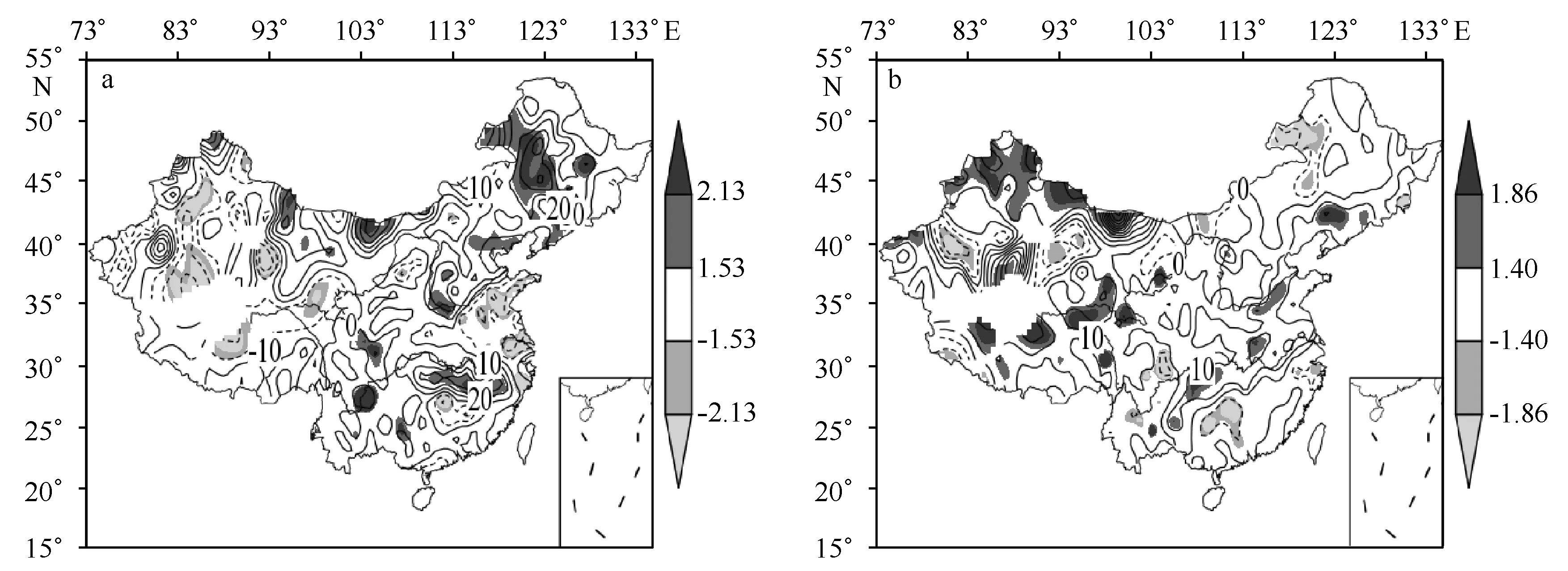
图7 EP-El Nio事件(a)、CP-El Nio(b)衰减阶段我国夏季降水距平百分率合成Fig.7 Composite summer percentage of precipitation anomalies during the decaying phase of EP-El Nio events (a) and CP-El Nio events (b) 等值线间隔: 10%, 深(浅)色阴影区表示正(负)异常分别通过信度0.20、0.10的显著性检验The interval of contour is 10%,deep/ shadow shaded denote positive /negative anomalies exceeding the 0.20 and 0.10 significance level, respectively

图8 E-W型(a)、W-E型(b)EP-El Nio次年夏季我国降水距平百分率合成和E-W型(c)、W-E型(d)EP-El Nio衰减阶段夏季合成的850 hPa风场距平合成Fig.8 Composite summer percentage of precipitation anomalies during the decaying phase of EP-El Nio events decaying in E-W pattern (a) and W-E pattern (b) and composite of summer 850 hPa winds anomalies during the decaying phase of EP-El Nio events decaying in E-W pattern (c) and W-E pattern (d)等值线间隔:20%, 深(浅)色阴影区表示正(负)异常分别通过信度0.20、0.10的显著性检验, 加粗箭头表示通过信度0.10的显著性检验, A表示反气旋性异常,C表示气旋性异常The interval of contour is 20%,deep/ shadow shaded denote positive /negative anomalies exceeding the 0.20 and 0.10 significance level, respectively. Bold arrows denote values exceeding the 0.10 significance level. A: anticyclonic anomalies, C: cyclonic anomalies
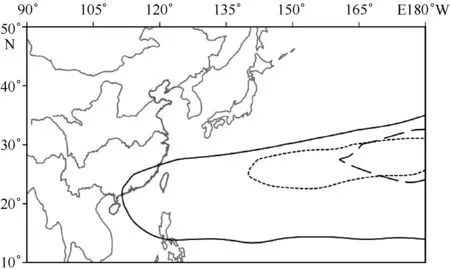
图9 E-W型(长虚线)、W-E型EP-El Nio(实线)衰减阶段夏季合成的500 hPa 588位势什米等值线(短虚线为1981—2010年的气候均值)Fig.9 Composite of summer 5 880 gpm at 500 hPa height during the decaying phase of EP-El Nio events decaying in E-W pattern (long dashed line) and W-E pattern (solid line) (short dashed line denotes the climatic summer 5 880 gpm height averaged from 1981 to 2010)

图10 S型(a)、P型(b)、A型(c)CP-El Nio衰减阶段夏季中国降水距平百分率合成和S型(d)、P型(e)、A型(f)CP-El Nio衰减阶段夏季合成的850 hPa风场距平Fig.10 Composite summer percentage of precipitation anomalies during the decaying phase of CP-El Nio events decaying in S pattern(a), P pattern(b) and A pattern (c) and composite of summer 850 hPa winds anomalies dur-ing the decaying phase of CP-El Nio events decaying in S pattern (d), P pattern (e) and A pattern (f)a、b中等值线间隔20%,c中等值线间隔10%;深(浅)色阴影区表示正(负)异常分别通过信度0.20、0.10的显著性检验;加粗箭头表示通过信度0.10的显著性检验;A:反气旋性异常The interval of contour in a and b is 20%. The interval of contour in c is 10%. Deep/ shadow shaded denote positive/negative anomalies exceeding the 0.20 and 0.10 significance level, respectively. Bold arrows denote values exceeding the 0.10 significance level. A: anticyclonic anomalies

图11 S型(长虚线)、P型(实线)、A型(点划线)CP-El Nio衰减阶段夏季合成的500 hPa副热带高压588位势什米等值线(短虚线为1981—2010年的气候均值)Fig.11 Composite of summer 5 880 gpm at 500 hPa height during the decaying phase of CP-El Nio events decaying in S pattern (long dashed line), P pattern (long dashed line) and A pattern (dash dot line) (short dashed line denotes the climatic summer 5 880 gpm height averaged from 1981 to 2010)
5 结论与讨论
[1] Trenberth K E,Stepaniak D P. Indices of El Nio Evolution[J]. Journal of Climate, 2001, 14:1697-1701.
[2] Jin F F, Kug J S, An S I, et al. A near-annual coupled ocean-atmosphere mode in the equatorial Pacific ocean[J]. Geophysical Research Letters, 2003, 30(2):1080.
[3] 林学椿,于淑秋.厄尔尼诺与我国汛期降水[J].气象学报,1993,51(4):434-441.
Lin Xuechun, Yu Shuqiu. El Nio and rainfall during the flood season (June-August) in China[J]. Acta Meteorologica Sinica, 1993,51(4):434-441.
[4] 史久恩,林学椿,周琴芳.厄尔尼诺现象和我国夏季(6-8月)降水、气温的关系[J].气象,1983(4):2-5.
Shi Jiuen, Lin Xuechun, Zhou Qinfang. El Nio and rainfall and temperature during the flood season (June-August) in China[J].Meteorology, 1983(4): 2-5.
[5] 黄荣辉,陈际龙,周连通,等.关于中国重大气候灾害与东亚气候系统之间关系的研究[J].大气科学,2003,27(4):770-787.
Huang Ronghui, Chen Jilong, Zhou Liantong, et al. Studies on the relationship between the severe climatic disasters in China and the East Asia climate system[J]. Chinese Journal of Atmospheric Sciences, 2003,27(4):770-787.
[6] 邹力,倪允琪.ENSO 对亚洲夏季风异常和我国夏季降水的影响[J].热带气象学报,1997,13(4):306-314.
Zou Li, Ni Yunqi. Impact of ENSO on the variability of the summer monsoon over Asia and the summer rainfall in China[J]. Journal of Tropical Meteorology,1997,13(4):306-314.
[7] Yeh S W, Kug J S, Dewitte B, et al. El Nio in a changing climate[J]. Nature, 2009, 461 (7263): 511-514.
[8] Yu J Y, Kim T. Three evolution patterns of central-Pacific El Nio[J]. Geophysical Research Letters, 2010, 37: L08706.
[9] Kug J S, Jin F F, An S I. Two types of El Nio events: cold tongue El Nio and warm pool El Nio[J]. Journal of Climate, 2009, 22: 1499-1515.
[10] Ashok K, Behera S K, Rao S A, et al. El Nio Modoki and its possible teleconnection[J]. Geophysical Research Letters, 2007, 112: C11007.
[11] Ashok K, Yamagata T. Climate change: The El Nio with a difference[J]. Nature, 2009, 461:481-484.
[12] 符淙斌,J.弗莱彻.“埃尔尼诺”(El Nio)时期赤道增暖的两种类型[J].科学通报,1985,8:596-599.
Fu Congbin, Fletcher J.Two types of the equatorial warming during El Nio[J].Chinese Science Bulletin,1985,8:596-599.
[13] Weng H, Behera S K, Yamagata T. Anomalous winter climate conditions in the Pacific rim during recent El Nio modoki and El Nio events[J]. Climate Dynamics, 2009, 32(5): 663-674.
[14] Zhang W J, Jin F F, Li J P, et al. Contrasting impacts of two-type El Nio over the western North Pacific during boreal autumn[J]. Journal of the Meteorological Society of Japan, 2011, 89(5): 563-569.
[15] 魏凤英,张先恭.埃尔尼诺与中国东部夏季降水异常分布[J].海洋学报,1994,16(6):58-65.
Wei Fengying,Zhang Xiangong.El Nio and summer precipitation anomaly over Eastern China[J].Haiyang Xuebao,1994,16(6):58-65.
[16] Feng J, Chen W, Tam C , et al. Different impacts of El Nio and CP-El Nio on China rainfall in the decaying phases[J]. International Journal of Climatology, 2011, 31(14): 2091-2101.
[17] 袁媛,杨辉,李崇银.不同分型厄尔尼诺事件及对中国次年夏季降水的可能影响[J].气象学报,2012,70(3):467-478.
Yuan Yuan,Yang Hui,Li Chongyin.Study of El Nio events of different types and their potential impact on the following-summer precipitation in China[J].Acta Meteorologica Sinica,2012,70(3):467-478.
[18] 赵永平,陈永利,张勐宁,等.两类ENSO 事件赤道太平洋次表层海温异常的演变特征[J].水科学进展,2006,17(1):7-13.
Zhao Yongping,Chen Yongli,Zhang Mengning, et al.Evolution characteristics of the subsurface temperature anomaly in the equatorial Pacific to two pattern ENSO events[J].Advances in Water Science,2006,17(1):7-13.
[19] Yu J Y,Kim S T. Three evolution patterns of central-Pacific El Nio[J]. Geophysical Research Letters, 2010, 37: L08706.
[20] Yuan Y,Yang S. Impacts of different types of El Nio on the east Asian climate: focus on ENSO cycles[J]. Journal of Climate, 2012, 25: 7702-7722.
[21] Wang J C, Wang X. Classifying CP-El Nio I and II classifying by different impacts on rainfall in southern China and typhoon tracks[J]. Journal of Climate, 2012, 26: 1322-1338.
[22] Kister R, Kalnay E, Collins W, et al. The NCEP-NCAR 50-year reanalysis: monthly means CD-ROM and documentation[J]. Bulletin of the American Meteorological Society, 2001, 82: 247-268.
[23] Rayner N A, Parker D E, Horton E B, et al. Global analyses of sea surface temperature, sea ice, and night marine air temperature since the late nineteenth century[J]. Journal of Geophysical Research, 2003, 108: No. D14, 4407.
[24] Ren H L, Jin F F. Nio indices for two types of ENSO[J]. Geophysical Research Letters, 2011, 38: L04704.
[25] 陈圣劼,何金海,吴志伟. 一种新的El Nio海气耦合指数[J]. 大气科学, 2013,37 (4): 815-828.
Chen Shengjie,He Jinhai,Wu Zhiwei. New ocean-atmosphere coupling indices for El Nio[J]. Chinese Journal of Atmospheric Sciences, 2013, 37 (4): 815-828.
[26] Gill A E. Some simple solutions for heat-induced tropical circulation[J]. Quarterly Journal of the Royal Meteorological Society, 1980 , 106 : 447-462.
Different decaying characteristics for two types of El Nio and their relationships with the summer rainfall in China
Chen Shengjie1,He Jinhai2
(1.JiangsuMeteorologicalObservatory,Nanjing210008,China;2.KeyLaboratoryofMeteorologicalDisasterofNUIST,Nanjing210044,China)
Different decaying characteristics for two types of El Nio and their relationships with the summer rainfall in China were investigated by using 743 stations daily precipitation data from China Meteorological Administration, NCEP circulation reanalysis datasets and the monthly mean Met Office Hadley Center sea surface temperature (SST) analyses data. Based on the evolution of the SST anomalies (SSTA) across the equator(5°S-5°N), two types of decaying patterns are identified for EP-El Nio: (1) An evolution pattern that SSTA decaying from east to west (E-W). The positive SSTA larger than 0.5℃ first disappear in offshore of South America and the disappearance extends to the west. (2) An evolution pattern that SSTA decaying from west to east (W-E). The positive SSTA larger than 0.5℃ first disappear in the central Pacific and the disappearance extends to the east. The decaying evolution of CP-El Nio is classified into three patterns: (1) A symmetric (S)—decaying pattern whose SSTA grows and decays symmetrically with respect to a peak phase, (2) A prolonged(P)-decaying pattern that is followed by a EP-El Nio type, (3) An abrupt(A)—decaying pattern that is followed by a EP-La Nia type. In the following summer of EP-El Nio in two different decaying patterns, there are almost completely opposite rainfall anomalies in North China, South China,the region between and the upstream area of the Yangtze River and the Yellow River Valley (they are called the Two River for short). In the following summer for E-W pattern, suppressed rainfall appears in the region between and the upstream area of the Two River , while the rainfall in North China is abundant and rainfall of the area to the south of the Yangtze River is slightly more. However, there are significantly positive anomalies in the region between and the upstream area of the Two River with the center of positive anomalies located along the Yangtze River, but the negative rainfall anomalies in most region of South China and North China for W-E pattern. As for three decaying patterns of CP-El Nio, the positive anomalies are present in the region between the Huaihe River and the Yellow River Valley for S pattern, in the Yangtze River Valley for P pattern, while in the lower reaches of the Yellow River for A pattern. Rainfall in the Northeast China, especially in the northern of Northeast China, is below normal for S and A pattern, while above normal for P pattern. In the Southwest China, wet (dry) signal appears for S (A) pattern. And in the northern of Northwest China,there is less (more) precipitation for A pattern (S and P pattern). Different distribution of summer rainfall anomalies in the decaying phase of El Nio is closely associated with their different decaying patterns. When inspecting the impacts of the two types of El Nio on the following summer rainfall, it would be better to consider their different decaying patterns in view of the larger significant area and T-inspection value of rainfall anomalies. All these will provide important reference for the short-term climate prediction of summer rainfall.
two “flavors” of El Nio; different decaying patterns; evolution characteristics; summer rainfall
10.3969/j.issn.0253-4193.2017.01.002
2016-05-12;
2016-07-15。
国家重点基础研究发展计划(973计划)子课题——热带太平洋海洋环流与暖池的结构特征、变异机理和气候效应”(2012CB417403)。
陈圣劼(1987—),女,江苏省如东县人,工程师,从事海气相互作用研究。E-mail:chenshengjieshiz@163.com
*通信作者:何金海(1941—),男,江苏省镇江市人,教授,主要研究东亚季风变化规律、大气低频振荡和旱涝机理。E-mail:hejhnew@nuist.edu.cn
P732.6
A
0253-4193(2017)01-0011-17
Chen Shengjie,He Jinhai. Different decaying characteristics for two types of El Nio and their relationships with the summer rainfall in China[J]. Haiyang Xuebao, 2017, 39(1): 11-27, doi:10.3969/j.issn.0253-4193.2017.01.002
